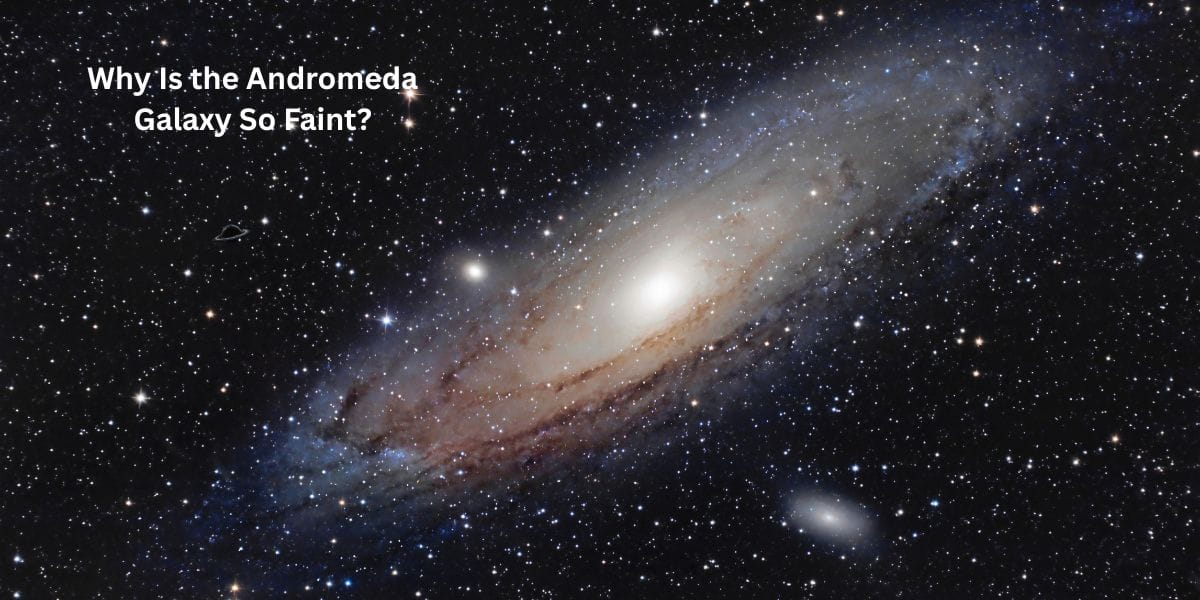Have you ever looked up at the night sky and seen a tiny, fuzzy patch of light? That might be the Andromeda galaxy, our closest galactic neighbor! Even though it’s the biggest galaxy near us, it doesn’t shine as brightly as stars or planets.
The Andromeda galaxy is huge—it has billions of stars, just like our Milky Way. But from Earth, it looks like a faint, cloudy spot. Why is that? If it’s so big, shouldn’t it be brighter? The answer is more interesting than you might think!
So, why does Andromeda look so dim in our sky? Let’s find out!
How Far Away Is the Andromeda Galaxy?
The biggest reason Andromeda looks faint is because it’s very, very far away. Even though it’s the closest spiral galaxy to us, it’s still about 2.5 million light-years from Earth.
To understand this distance, imagine this:
- If you could travel at the speed of light (the fastest speed possible), it would take you 2.5 million years to reach Andromeda!
- The stars we see at night are much closer—only a few light-years away. That’s why they look brighter.
Even though Andromeda is huge, distance makes it appear dim.
Is the Andromeda Galaxy Brighter Than It Looks?
Yes! Andromeda is actually much brighter than it seems from Earth. Here’s why:
- It contains over a trillion stars (our Milky Way has about 200–400 billion).
- If we were closer, Andromeda would light up our sky like a giant cosmic cloud.
But because its light spreads out over such a great distance, only a small amount reaches us. Think of it like a flashlight:
- Shine it right in your face—it’s very bright.
- Move far away—the light looks weak, even though the flashlight is just as strong.
Andromeda is like that flashlight, but on a galactic scale!
Can We See the Andromeda Galaxy With the Naked Eye?
Yes! But only under the right conditions:
- You need a very dark sky (no city lights).
- It looks like a small, hazy patch—not sharp like a star.
- The best time to see it is in autumn and winter (in the Northern Hemisphere).
Fun fact: Andromeda is the farthest object you can see without a telescope!
Why Doesn’t Andromeda Shine Like a Star?
Stars are tiny compared to galaxies, but they look brighter because:
- Stars are much closer (the Sun is only 8 light-minutes away).
- Galaxies like Andromeda have stars spread out over huge distances, so their light blends into a soft glow.
Imagine comparing a single light bulb (a star) to a huge chandelier (a galaxy). From far away, the chandelier looks dimmer, even though it has more bulbs!
Will Andromeda Ever Look Brighter in the Sky?
Yes! Andromeda is moving toward our Milky Way. In about 4 billion years, the two galaxies will collide and merge. When that happens:
- Andromeda will get closer, so it’ll look bigger and brighter.
- The night sky will change forever—new stars will form, and the two galaxies will mix.
But don’t worry—this won’t happen in our lifetime!
Conclusion
The Andromeda galaxy looks faint because it’s incredibly far away—even though it’s packed with stars. Distance makes its light spread out, so we only see a soft glow. But if we were closer, it would light up our sky like a cosmic fireworks show!
Next time you look up, try spotting Andromeda. It’s amazing to think that tiny fuzzy patch is actually a giant galaxy heading our way!
📌 Frequently Asked Questions
Can I see the Andromeda galaxy without a telescope?
Yes! From a dark location, Andromeda looks like a faint, fuzzy patch. It’s the farthest object visible to the naked eye.
How big is the Andromeda galaxy compared to the Milky Way?
Andromeda is slightly larger, with about 1 trillion stars, while the Milky Way has 200–400 billion.
Will the Andromeda galaxy hit Earth?
No—galaxies are mostly empty space. Even when Andromeda and the Milky Way collide, stars and planets won’t crash.
Why is Andromeda called a galaxy?
It’s a massive group of stars, gas, and dust held together by gravity—just like our Milky Way.
Can Andromeda be seen from the Southern Hemisphere?
Yes, but it’s harder. It’s best seen from the Northern Hemisphere in autumn and winter.
How old is the Andromeda galaxy?
About 10 billion years old—older than our Milky Way!
What color is the Andromeda galaxy?
Mostly blue (from young stars) and red (from older stars).
How fast is Andromeda moving toward us?
About 110 km per second—but it’ll take billions of years to reach us.
Are there planets in the Andromeda galaxy?
Probably! But they’re too far away for us to detect yet.
Will humans ever travel to Andromeda?
Not with current technology. It’s 2.5 million light-years away—too far for any spacecraft!
